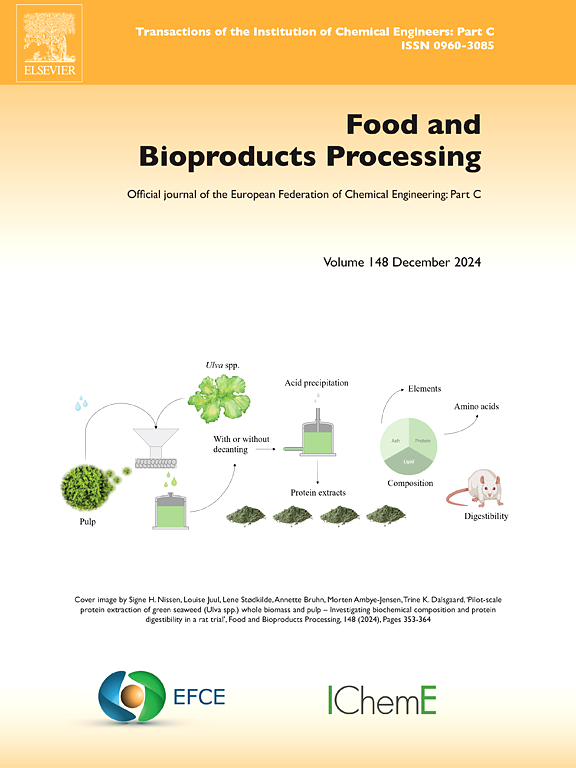Sustainable cultivation of Gracilaria edulis in poultry manure-derived media: Evaluating growth, biochemical properties, and agar quality
IF 3.5
2区 农林科学
Q2 BIOTECHNOLOGY & APPLIED MICROBIOLOGY
引用次数: 0
Abstract
Present study investigates the potential of Gracilaria edulis, a red seaweed and a valuable source of food grade agar, to mass generate seedlings without stimulants, to grow and produce biomass in poultry manure derived nutrients, and to possess industry standard physico-chemical & proximate compositional biochemical attributes post-cultivation. From this study, for the purpose of producing clonal planting material, G. edulis explants showed near 100 % regeneration in seedling development in incubation in PES medium. Simple and yet efficient water-sonicate method extracted substantial amount of nutrients from the poultry manure, and the resultant formulated poultry manure aqueous-sonicate extract supplemented seawater, in short PMES, was enriched with significant levels of micronutrients (Cu–5.3 µM, Zn–11.7 µM and Mn–28.4 µM), and macronutrients (N: 311–1555 µM and P: 12–63 µM) compared to sole seawater. In incubation with various concentration of PMES (1–5 %, v/v), G. edulis seedlings exhibited robust growth characteristics across all the PMES, with the highest daily growth rate (9.9 ± 0.9 % day⁻¹) and biomass yield (202.5 ± 12.6 mg dry weight L⁻¹) observed in 2 % PMES, which significantly surpassing the growth characteristics of G. edulis seedlings grown in sole seawater as growth medium. Resultant G. edulis produced biomass from this study had superior oil-holding capacity (3.60 g/g dry weight), substantial soluble polysaccharide content (31.47 % of dry weight), and ash content (44.93 % of dry weight), alongside considerable crude fibre content (7.73 % of dry weight) compared to wild G. edulis and other commercially important seaweeds. Moreover, the biomass had 26 % agar which was substantial and higher than that of its wild counterparts, with the extracted agar displaying characteristic functionalities, as confirmed by infrared spectroscopy and thermal analysis, comparable to commercial agar. These findings demonstrate that G. edulis as novel macroalgae and PMES as a sustainable cost-effective growth medium for seaweed cultivation, offering promising implications in agar and seaweed food industry.
求助全文
约1分钟内获得全文
求助全文
来源期刊

Food and Bioproducts Processing
工程技术-工程:化工
CiteScore
9.70
自引率
4.30%
发文量
115
审稿时长
24 days
期刊介绍:
Official Journal of the European Federation of Chemical Engineering:
Part C
FBP aims to be the principal international journal for publication of high quality, original papers in the branches of engineering and science dedicated to the safe processing of biological products. It is the only journal to exploit the synergy between biotechnology, bioprocessing and food engineering.
Papers showing how research results can be used in engineering design, and accounts of experimental or theoretical research work bringing new perspectives to established principles, highlighting unsolved problems or indicating directions for future research, are particularly welcome. Contributions that deal with new developments in equipment or processes and that can be given quantitative expression are encouraged. The journal is especially interested in papers that extend the boundaries of food and bioproducts processing.
The journal has a strong emphasis on the interface between engineering and food or bioproducts. Papers that are not likely to be published are those:
• Primarily concerned with food formulation
• That use experimental design techniques to obtain response surfaces but gain little insight from them
• That are empirical and ignore established mechanistic models, e.g., empirical drying curves
• That are primarily concerned about sensory evaluation and colour
• Concern the extraction, encapsulation and/or antioxidant activity of a specific biological material without providing insight that could be applied to a similar but different material,
• Containing only chemical analyses of biological materials.
 求助内容:
求助内容: 应助结果提醒方式:
应助结果提醒方式:


